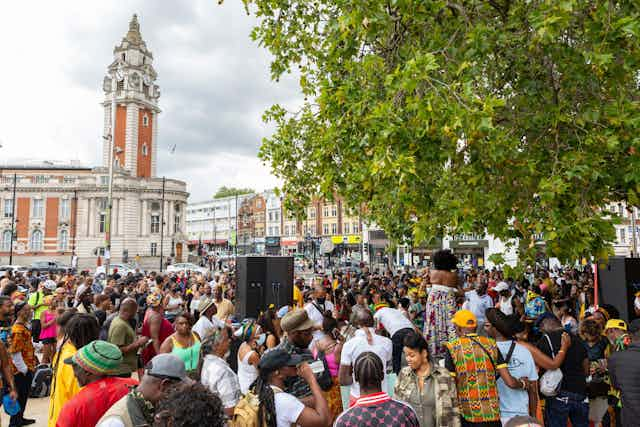Windrush Square is a vibrant public plaza at the heart of Brixton, in the London borough of Lambeth. It was first named in 1998 in commemoration of the arrival of the Empire Windrush, which docked in Essex in 1948, carrying 1,027 passengers, at least 500 of whom were from the Caribbean.
In 2010, Boris Johnson, as Mayor of London, oversaw an extension of the square to include the adjacent Tate Gardens, so named for erstwhile Lambeth resident and sugar merchant Henry Tate. Responding to a Lambeth council opinion poll, local residents decided that this larger, more open space – newly furnished with lighting, benches and sculptures – would continue to be known as Windrush Square.
Lifelong Brixton resident, Windrush descendant and community organiser Ros Griffiths chairs the Friends of Windrush Square group. This independent collection of residents, activists and business representatives (which includes the Black Cultural Archives, Brixton Blog, Black Culture Market and Repowering London) exists, as its mission statement puts it, to protect and promote “the heritage, function, and architecture” of the square. It does so by advocating for initiatives that generate social value – in other words, that benefit the local community.
My research looks at how public space can facilitate a sense of belonging and make diverse societies more cohesive. Windrush Square offers an instructive example of how crucial it is that any urban development project be, as Griffiths argues, “people-led.”

Contested heritage
When Commonwealth citizens – now known collectively as the Windrush generation – were invited by the UK government to support post-war reconstruction, they arrived in Britain and settled in neighbourhoods all over the country, but especially in south London. Today, 43% of Lambeth’s population is Black, Asian or multi-ethnic, with Black/Black British African making up 12%, and Black/Black British Caribbean accounting for 10% of the borough’s residents.
Amid growing political polarisation and a national identity crisis, quite how that history is reflected in our built environment is an ongoing and sometimes contentious debate.
Windrush Square speaks eloquently to this history. It boasts a number of memorials, including the UK’s first memorial to African and Caribbean service personnel and the Cherry Groce memorial pavillion, installed in honour of Cherry Groce, a Jamaican woman who was shot by the police in her Brixton home in 1985.

The square also features a bust of Henry Tate, first unveiled in 1905, in front of Brixton Library. As Griffiths outlines, local sentiments about Tate’s ongoing prominence on Windrush Square are mixed:
We still need to have a conversation about that history.
Research shows that Tate was not personally implicated in colonial slavery. However, links between the transatlantic slave trade and the broader sugar industry are incontrovertible.
In 2022, Friends of Windrush Square launched the Reimagining Windrush Square campaign to both reexamine this history and rethink how the square is used today.
The group questions the increasing number of commercial events across public spaces in Lambeth. They also question how the square has been reworked to date.

The 2010 redesign, by landscape architects Gross Max, was part of the Mayor of London’s 100 Public Spaces Initiative. While some urban planners viewed the resulting openness, improved lighting and design features as bringing coherence to the public realm, other observers criticised the changes for the impact on how it was used.
Chairs and greenery had been removed. The public toilets remained closed. Griffiths put it plainly:
The 2010 redevelopment of Windrush Square was design-led. It should have been people-led.
The subsequent installation of 155 security bollards in 2020 also drew local ire. The bollards reportedly cost £13,000 each and the terrorism threat, with which their presence had initially been justified, turned out to be non-existent.

The Friends of Windrush Square, instead, want to see Windrush Square used in a way that benefits the local community. They would love, for example, to see the disused public toilets converted into a community hub. As Griffiths says:
Friends of Windrush Square is my legacy. The history matters, but we’re imagining what Windrush Square could be in 2048.
My colleagues and I have worked with the group on a series of community research labs. Our aim is to support that reimagining initiative through shared reflection on challenges, priorities and solutions, and to co-develop a local place plan which outlines the group’s long-term vision.
London has over 900 Friends of Parks groups, like Friends of Windrush Square, which collectively count around 100,000 members. These groups care for a variety of public spaces.
Some, like Windrush Square, are on publicly owned land. Others are part of a growing number of privately owned public spaces. These are managed inconsistently – quite who is permitted to use them depends largely on the private landowners’ attitudes, with local authorities, or people, given little say.
The city government appears to want to keep public space public. Mayor of London Sadiq Khan’s spatial development strategy for Greater London, dubbed London Plan 2021, highlights how important it is for local communities to support urban development projects.
The Public London Charter, meanwhile, which details guidance for the capital’s new public spaces, emphasises unrestricted access, regardless of who the land in question belongs to. This does not however apply to existing spaces, which may have been redeveloped following other priorities.
Voluntary groups have a shared connection to, and concern for, the spaces they inhabit. They challenge the troubling trend toward privatisation of civic spaces. They show that people want to talk about and be involved in transforming the spaces they inhabit, in a way that benefits the collective. Harnessing their voices is essential to creating a public realm that works for everyone.
The Big Caribbean Lunch takes place on June 25 2023 in Windrush Square. To take part in reimagining the square’s future, sign up to the Friends of Windrush Square engagement hub. Find out about other Windrush 75 anniversary events in Lambeth and across the UK.

